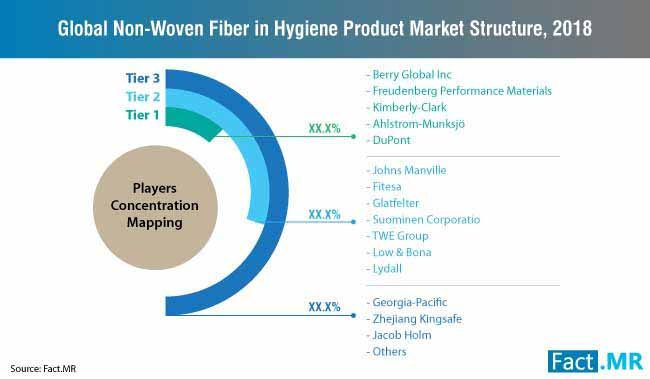
Global Non-Woven Fibers in Hygiene Products Market Size, Status and Forecast 2020-2026
Global “Non-Woven Fibers in Hygiene Products Market” 2020 Research report provides information regarding market size, share, trends, growth, cost structure, global market competition landscape, market drivers, challenges and opportunity, capacity, revenue and forecast 2026. This report also includes the overall and comprehensive study of the Non-Woven Fibers in Hygiene Products market with all its aspects influencing the growth of the market. This report is exhaustive quantitative analyses of the Non-Woven Fibers in Hygiene Products industry and provides data for making strategies to increase the market growth and effectiveness.
The report presents the market competitive landscape and a corresponding detailed analysis of the major vendor/key players in the market.
Request Sample Report @ https://www.factmr.co/connectus/sample?flag=S&rep_id=3104
Global Non-Woven Fibers in Hygiene Products Market Split by Product Type and Applications:
Competitive Landscape

- In order to meet the burgeoning demand for non-woven fiber in hygiene products, Kimberly-Clark invested US$ 30 million in 2018 for expanding and upgrading its facility in Hendersonville, North Carolina. The production plant specifically produces non-woven fibers for its clients in the adult and feminine hygiene care sector including the likes of Poise, Depend, and U by Kotex.
- To capitalize on the growing demand for non-woven fiber in hygiene products in Asia, Fiesta, a leading player operating in the non-woven fiber in hygiene product market, bought 51% of the stake in spunbound non-woven fiber manufacturer CNC International. Fitesa plans to align the operations of the new acquisition to focus on the hygiene products market.
- In order to expand its market presence, Galtfelter, a leading player operating in the non-woven fiber in hygiene product market, announced the purchase of Georgia-Pacific’s European non-woven business in 2018. Under the purchase, Galtfelter acquired Georgia-Pacific’s state-of-the-art 32,000-metric-ton manufacturing facility in Steinfurt, Germany for US$ 185 million.
- Proctor & Gamble and Drylock announced that the companies will be entering a global license agreement to expand research into the development of channel technology used in enhancing the performance of products such as baby diapers and adult incontinence diaper and pants.
The leading players operating in the market include Freudenberg Performance Materials, DuPont, Berry Global Inc., and Ahlstorm-Munksjö. Other players operating in this market are Johns Manville, Suominen Corporation, Low & Bona, Lydall, TWE Group, Jacob Holm, and Zhejiang Kingsafe.
Note: Fact.MR research offers compelling insights into the competitive landscape of the non-woven fiber in hygiene product market. A summary of the report is available on request.
Additional Insight:
Demand for Fluff Pulp to Remain Robust in Baby Diapers Manufacturing
Non-woven fibers can be broadly divided into super absorbent materials (SAP), fluff pulp, stretch non-woven, polyester, and filaments. Among these materials, demand for fluff pulp continues to remain robust in the manufacturing of baby diapers, feminine hygiene, and adult incontinence. In addition to its superior absorbent properties, fluff pulp is increasingly being used in the development of composite non-woven fibers with increased loft and improved three-dimensional relief structure.
Growing awareness about the negative impact of using cloth diapers on babies’ skin is further driving the demand for fluff pulp in the manufacturing of diapers. Coupled with the substantial rise in the disposable income of the global population, the production of baby diapers is estimated to increase, which in turn, is eventually expected to propel the demand for fluff pump. The factors are estimated to contribute significantly to non-woven fiber in hygiene product market growth.
Non-woven fiber manufacturers are further gaining increasing control over the finished products using different technologies such as spun melt, wet laid, dry laid, and air laid.
Research Methodology
A robust and extensive research methodology was employed to unearth invaluable information about the non-woven fiber in hygiene product market. Primary and secondary researches were conducted to obtain actionable insights into the non-woven fiber in hygiene product market. While primary research involved interviewing seasoned experts from the industry, secondary research was conducted by thoroughly studying trade journals, paid sources, and other industry-related publications. Results from both the steps of research were triangulated to produce an accurate and authentic forecast of the non-woven fiber in hygiene product market.
Scope of the Report

Request Methodology On This Report @ https://www.factmr.co/connectus/sample?flag=RM&rep_id=3104
Influence of the Non-Woven Fibers in Hygiene Products Market Report:
- Comprehensive assessment of all opportunities and risk in the Non-Woven Fibers in Hygiene Products market.
- Detailed study of business strategies for growth of the Non-Woven Fibers in Hygiene Products market-leading players.
- Conclusive study about the growth plot of Non-Woven Fibers in Hygiene Products market for forthcoming years.
- In-depth understanding of Non-Woven Fibers in Hygiene Products market-particular drivers, constraints and major micro markets.
- Favourable impression inside vital technological and market latest trends striking the Non-Woven Fibers in Hygiene Products market.
What are the market factors that are explained in the report?
-Key Strategic Developments: The study also includes the key strategic developments of the market, comprising R&D, new product launch, M&A, agreements, collaborations, partnerships, joint ventures, and regional growth of the leading competitors operating in the market on a global and regional scale.
-Key Market Features: The report evaluated key market features, including revenue, price, capacity, capacity utilization rate, gross, production, production rate, consumption, import/export, supply/demand, cost, market share, CAGR, and gross margin. In addition, the study offers a comprehensive study of the key market dynamics and their latest trends, along with pertinent market segments and sub-segments.
-Analytical Tools: The Global Non-Woven Fibers in Hygiene Products Market report includes the accurately studied and assessed data of the key industry players and their scope in the market by means of a number of analytical tools. The analytical tools such as Porter’s five forces analysis, SWOT analysis, feasibility study, and investment return analysis have been used to analyze the growth of the key players operating in the market.
Ask analyst about this report at https://www.factmr.co/connectus/sample?flag=AE&rep_id=3104